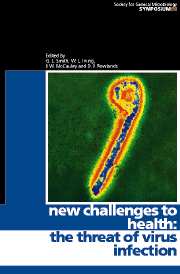Book contents
- Frontmatter
- Contents
- Contributors
- Editors' Preface
- 1 The viruses in our past, the viruses in our future
- 2 Dynamics and epidemiological impact of microparasites
- 3 The continuing threat of bunyaviruses and hantaviruses
- 4 Calicivirus, myxoma virus and the wild rabbit in Australia: a tale of three invasions
- 5 Potential of influenza A viruses to cause pandemics
- 6 The hepatitis viruses as emerging agents of infectious diseases
- 7 The emergence of human immunodeficiency viruses and AIDS
- 8 Morbilliviruses: dangers old and new
- 9 Structure–function analysis of prion protein
- 10 Endogenous retroviruses and xenotransplantation
- 11 Gammaherpesviral infections and neoplasia in immunocompromised populations
- 12 Structure and function of the proteins of Marburg and Ebola viruses
- 13 Epidemic dengue/dengue haemorrhagic fever as a public health problem in the 21st century
- 14 Borna disease virus – a threat for human mental health?
- 15 Antiviral drug development and the impact of drug resistance
- Index
10 - Endogenous retroviruses and xenotransplantation
Published online by Cambridge University Press: 06 July 2010
- Frontmatter
- Contents
- Contributors
- Editors' Preface
- 1 The viruses in our past, the viruses in our future
- 2 Dynamics and epidemiological impact of microparasites
- 3 The continuing threat of bunyaviruses and hantaviruses
- 4 Calicivirus, myxoma virus and the wild rabbit in Australia: a tale of three invasions
- 5 Potential of influenza A viruses to cause pandemics
- 6 The hepatitis viruses as emerging agents of infectious diseases
- 7 The emergence of human immunodeficiency viruses and AIDS
- 8 Morbilliviruses: dangers old and new
- 9 Structure–function analysis of prion protein
- 10 Endogenous retroviruses and xenotransplantation
- 11 Gammaherpesviral infections and neoplasia in immunocompromised populations
- 12 Structure and function of the proteins of Marburg and Ebola viruses
- 13 Epidemic dengue/dengue haemorrhagic fever as a public health problem in the 21st century
- 14 Borna disease virus – a threat for human mental health?
- 15 Antiviral drug development and the impact of drug resistance
- Index
Summary
THE PROMISE OF XENOTRANSPLANTATION
Every year, thousands of patients with chronic endstage organ failure will die while on the waiting lists for potentially life-saving transplant surgery. Many others will not even make the waiting lists, as they are judged less likely to benefit from scarce human organs. The transplantation of foetal neural cells or foetal islets shows great potential for the treatment of individuals with Parkinson's disease or Type I diabetes, but again the number of potential beneficiaries from such therapies is limited by the availability of donor tissue.
Over the years, such shortages have prompted a number of investigators to explore the possibility of using non-human sources of organs and cells for transplantation into humans. Until now, such efforts have met with little success, but a number of recent developments in biomedical science have appeared to confirm the potential of such approaches (Cooper & Lanza, 2000). Over the coming years, such efforts are likely to become much more frequent as increasing numbers of physicians and surgeons seek to tap into the potential of techniques involving the transplantation of cells, tissues or whole organs from other species into humans, procedures collectively known as xenotransplantation.
SOURCE ANIMALS FOR XENOTRANSPLANTATION
To date, most animal to human xenotransplantation protocols have featured the use of non-human primates as source animals because the close evolutionary relationship to humans might be expected to minimize problems of rejection and to maximize the probability of physiological compatibility between graft and recipient. However, opinion has now turned firmly against the use of non-human primates, partly on ethical and partly on practical and safety grounds (see US Food and Drug Administration Guidance Notice at http://www.fda.gov/cber/gdlns/xenoprim.txt).
- Type
- Chapter
- Information
- New Challenges to HealthThe Threat of Virus Infection, pp. 195 - 212Publisher: Cambridge University PressPrint publication year: 2001



